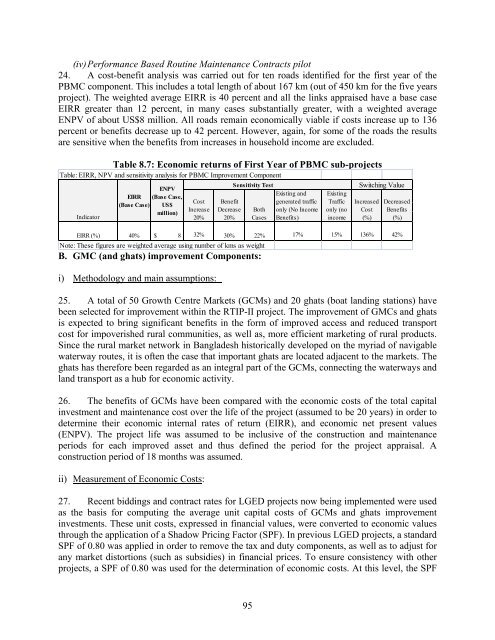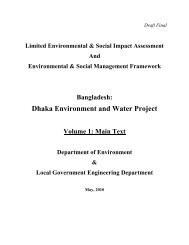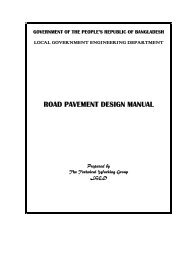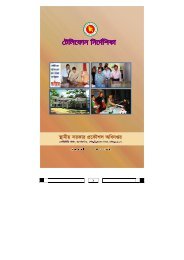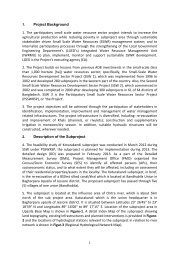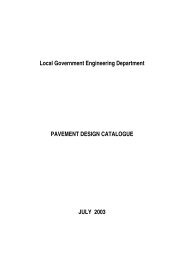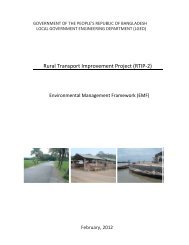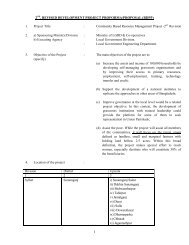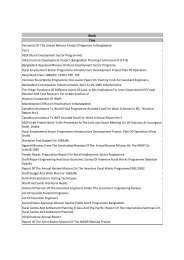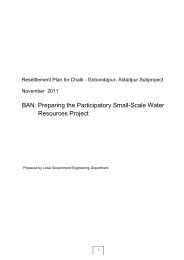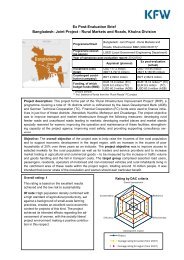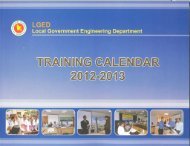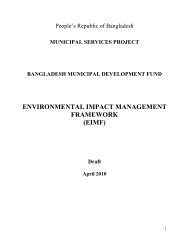PAD - LGED
PAD - LGED
PAD - LGED
Create successful ePaper yourself
Turn your PDF publications into a flip-book with our unique Google optimized e-Paper software.
(iv) Performance Based Routine Maintenance Contracts pilot<br />
24. A cost-benefit analysis was carried out for ten roads identified for the first year of the<br />
PBMC component. This includes a total length of about 167 km (out of 450 km for the five years<br />
project). The weighted average EIRR is 40 percent and all the links appraised have a base case<br />
EIRR greater than 12 percent, in many cases substantially greater, with a weighted average<br />
ENPV of about US$8 million. All roads remain economically viable if costs increase up to 136<br />
percent or benefits decrease up to 42 percent. However, again, for some of the roads the results<br />
are sensitive when the benefits from increases in household income are excluded.<br />
Table 8.7: Economic returns of First Year of PBMC sub-projects<br />
Table: EIRR, NPV and sensitivity analysis for PBMC Improvement Component<br />
Indicator<br />
ENPV<br />
EIRR (Base Case,<br />
(Base Case) US$<br />
million)<br />
Cost<br />
Increase<br />
20%<br />
Benefit<br />
Decrease<br />
20%<br />
Sensitivity Test<br />
Both<br />
Cases<br />
EIRR (%) 40% $ 8 32% 30% 22% 17% 15% 136% 42%<br />
Note: These figures are weighted average using number of kms as weight<br />
B. GMC (and ghats) improvement Components:<br />
i) Methodology and main assumptions:<br />
Existing and<br />
generated traffic<br />
only (No Income<br />
Benefits)<br />
Existing<br />
Traffic<br />
only (no<br />
income<br />
Switching Value<br />
Increased<br />
Cost<br />
(%)<br />
Decreased<br />
Benefits<br />
(%)<br />
25. A total of 50 Growth Centre Markets (GCMs) and 20 ghats (boat landing stations) have<br />
been selected for improvement within the RTIP-II project. The improvement of GMCs and ghats<br />
is expected to bring significant benefits in the form of improved access and reduced transport<br />
cost for impoverished rural communities, as well as, more efficient marketing of rural products.<br />
Since the rural market network in Bangladesh historically developed on the myriad of navigable<br />
waterway routes, it is often the case that important ghats are located adjacent to the markets. The<br />
ghats has therefore been regarded as an integral part of the GCMs, connecting the waterways and<br />
land transport as a hub for economic activity.<br />
26. The benefits of GCMs have been compared with the economic costs of the total capital<br />
investment and maintenance cost over the life of the project (assumed to be 20 years) in order to<br />
determine their economic internal rates of return (EIRR), and economic net present values<br />
(ENPV). The project life was assumed to be inclusive of the construction and maintenance<br />
periods for each improved asset and thus defined the period for the project appraisal. A<br />
construction period of 18 months was assumed.<br />
ii) Measurement of Economic Costs:<br />
27. Recent biddings and contract rates for <strong>LGED</strong> projects now being implemented were used<br />
as the basis for computing the average unit capital costs of GCMs and ghats improvement<br />
investments. These unit costs, expressed in financial values, were converted to economic values<br />
through the application of a Shadow Pricing Factor (SPF). In previous <strong>LGED</strong> projects, a standard<br />
SPF of 0.80 was applied in order to remove the tax and duty components, as well as to adjust for<br />
any market distortions (such as subsidies) in financial prices. To ensure consistency with other<br />
projects, a SPF of 0.80 was used for the determination of economic costs. At this level, the SPF<br />
95


